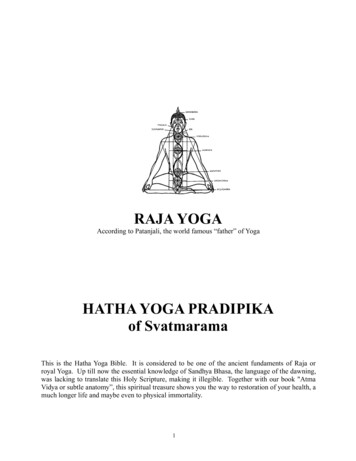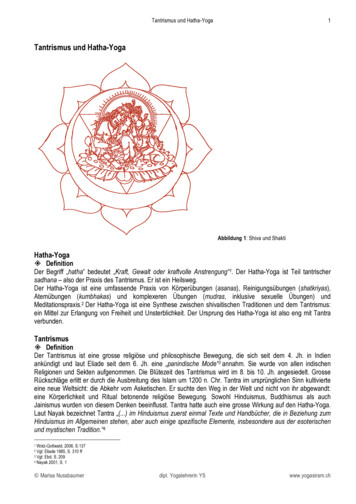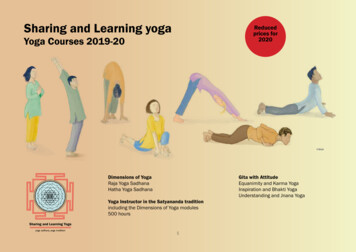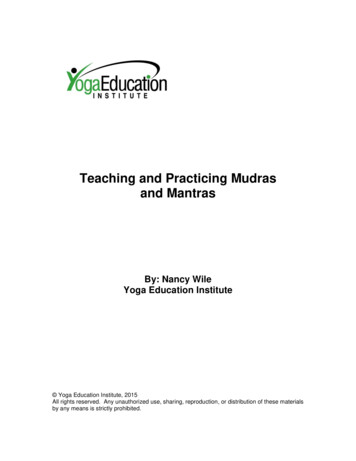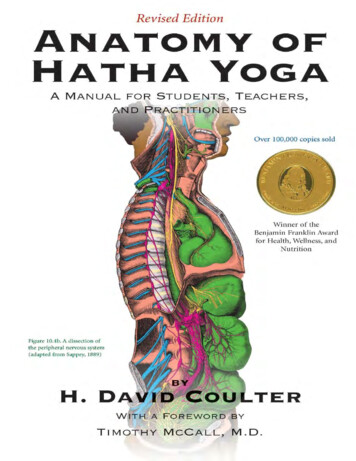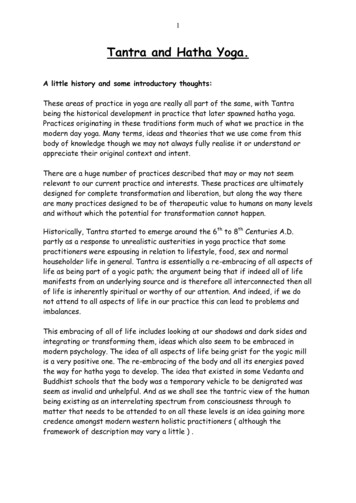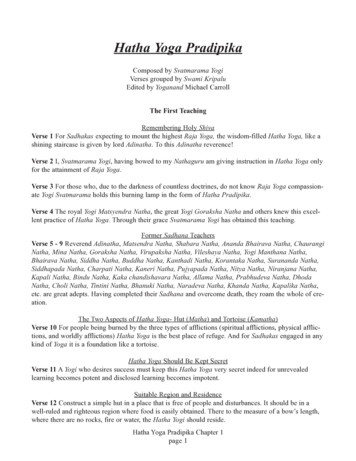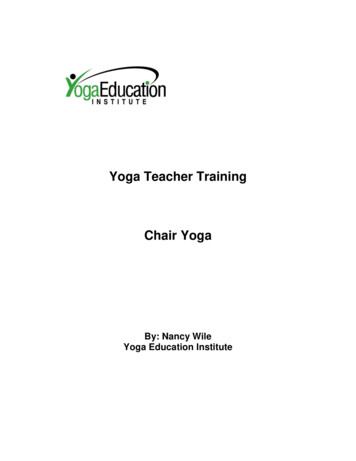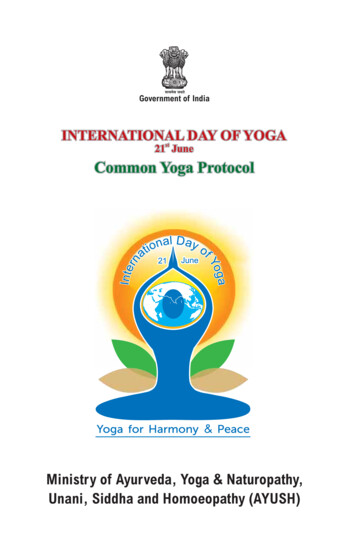
Transcription
Hatha Yoga PradipikaLight on Hatha YogaWith kind regards,and prem
Hatha YogaPradipikaLight on Hatha YogaIncluding the original Sanskrit text of the Hatha YogaPradipika with translation in EnglishCommentary bySwami MuktibodhanandaUnder the Guidance ofSwami Satyananda SaraswatiYoga Publications Trust, Munger, Bihar, India
Bihar School of Yoga 1985, 1993, 1998All rights reserved. No part of this publication may be reproduced,transmitted or stored in a retrieval system, in any form or by anymeans, without permission in writing from Yoga PublicationsTrust.The terms Satyananda Yoga and Bihar Yoga are registered trademarksowned by International Yoga Fellowship Movement (IYFM). The use of thesame in this book is with permission and should not in any way be taken asaffecting the validity of the marks.Published by Bihar School of Yoga First edition 1985Second edition 1993 Third edition 1998Published by Yoga Publications TrustReprinted 2000, 2001, 2002, 2003, 2004, 2005, 2006ISBN: 81-85787-38-7Publisher and distributor: Yoga Publications Trust, Ganga Darshan,Munger, Bihar, India.Website: www.yogavision.netPrinted at Thomson Press (India) Limited, New Delhi, 110001Saved and digitally reproduced for the modern information age in 2013 by Majestic Muse.Please share.
DedicationIn humility we offer this dedication toSwami Sivananda Saraswati, who initiatedSwami Satyananda Saraswati into thesecrets of yoga.
ContentsVerseChapter One: AsanaPage12345-9101112, 1314Salutations to ShivaPurpose of hatha yogaState of raja yoga is unknown because of misconceptionFirst of the hatha yogis; Matsyendranath and GorakhnathLineage of mahasiddhasThree types of pain or tapaSadhana should be kept secret for successPlace of practicePractice of sadhana devoid of mental tension, according toguru’s instruction15Causes of failure in sadhana16(i)Causes of success in sadhana(ii & iii) Yama and niyama17Asana as the first stage of hatha yoga18Asana as described by Vashishtha and Matsyendranath19Swastikasana (auspicious pose)20Gomukhasana (cow’s face pose)21Veerasana (hero’s pose)22Koormasana (tortoise pose)23Kukkutasana (cockerel pose)24Uttankoormasana (stretching tortoise pose)25Dhanurasana (bow pose)26Matsyendrasana (spinal twist pose)27Benefits of matsyendrasana28Paschimottanasana (back stretching pose)29Benefits of paschimottanasanai2327293032343740, 434750545667686971747678808285889093
VersePage30313233, 34Mayurasana (peacock pose)94Curative effects of mayurasana96Shavasana (corpse pose) and its benefits98Four major asanas of the eighty four taught by Shiva; theexcellence of siddhasana100, 101Siddhasana (adept’s pose)102Variation of siddhasana106Difference between siddhasana, vajrasana, muktasana andguptasana107Siddhasana is the most important asana109Siddhasana purifies the nadis110Perfection of sadhana takes twelve years111Perfection is attainable by siddhasana alone113Through siddhasana the bandhas occur spontaneously115No asana can rival siddhasana116Padmasana (lotus pose)117Method of awakening the shakti with padmasana123Method of liberation with padmasana; explanation of maruta124Simhasana (lion’s pose)127Bhadrasana (gracious pose)130Sequence of hatha yoga practice132Perfection after one year134Mitahara - moderate diet135Food which is prohibited to the hatha sadhaka137, 138Interactions to be avoided by the hatha yogi139Food which is conducive to hatha sadhana141, 142Those who can practice hatha yoga143Perfection results from practice143Neither the garb nor mere talk gives siddhi but only practicalapplication143Asana, pranayama, etc. should be practiced until perfection orsiddhi is achieved14535363738394041424344-47484950-5253, 5455, 56575859, 606162, 6364656667ii
VerseChapter Two: Shatkarma and Pranayama12PageBeing established in asana, pranayama should be practiced149Interconnection of mind and prana and their steadying throughpranayama1503What is life and death; the five functions of vayu1534Impurities of the nadis, cleaning the middle channel1585Purification of the nadis and chakras for retention of prana1606Sattwic state of mind for pranayama; the three gunas1647-9Nadi shodhana pranayama (alternate nostril breathing)16610Alternate nostril breathing purifies the nadis within three months 17011Times and duration of practice17312Signs of perfected pranayama practice17513Rubbing the body with perspiration17714Diet and pranayama17815Control of prana to prevent destruction of the force17916, 17 Eradication of diseases by proper practice, otherwise,bad results180, 18118Skilful control of breath leads to siddhi18219, 20 Signs and results of purifying the nadis18321Shatkarma should precede pranayama if fat and mucus areexcessive18522Shatkarma - six purificatory techniques18623Shatkarma is secret, bringing wondrous results18824Dhauti (internal cleansing)19025Dhauti cures many diseases19626Basti (yogic enema)19727, 28 Curative effects of basti20029Neti (nasal cleansing)20230Benefits of neti206iii
Verse313233343536373839404142434445464748, 495051, 52535455, 5657, 5859-6566, 67686970PageTrataka (concentrated gazing)208Curative effects of trataka212Nauli (abdominal massaging)215Benefits of nauli219Kapalbhati (frontal brain cleansing)220Freedom from the excesses of doshas through shatkarma224Some say pranayama alone removes impurities225Gaja karani (elephant stomach cleansing)226Even Brahma and the gods practice pranayama228When kumbhaka and shambhavi are maintained, fear ofdeath diminishes229Restraining the breath purifies the nadis and chakras andawakens sushumna230Manonmani (mind devoid of thought)231Practice of kumbhaka brings perfection232Names of the eight kumbhaka practices232Practice of bandha with pranayama234Maha bandha directs prana into brahma nadi234Uniting of prana and apana banishes old age236Suryabheda pranayama (vitality stimulating breath)237Curative effects of suryabheda pranayama237Ujjayi pranayama (psychic breath)240Curative effect of ujjayi pranayama240Seetkari pranayama (hissing breath)243Benefits of seetkari pranayama246-248Sheetali pranayama (cooling breath)249Bhastrika pranayama (bellows breath)252-253Benefits of bhastrika pranayama; piercing of the three granthis257Bhramari pranayama (humming bee breath)260Moorchha pranayama (swooning breath)263Plavini pranayama (gulping breath)266iv
Verse71-7475-7778PagePranayama is of three types; kevala kumbhakaPerfection of hatha yoga and raja yoga, through kevalakumbhakaSigns of perfection in hatha yoga268270, 272274Chapter Three: Mudra and Bandha123456, 78910-13141516171819-2223242526-2829, 303132-3637Kundalini is the support of yoga practices279Guru’s grace and opening of the chakras280Sushumna becomes the path of prana and deceives death283Names of sushumna284Sleeping goddess is awakened by mudra286Ten mudras destroy old age287Eight major siddhis obtained by mudra289Mudras must be kept secret290Maha mudra (the great attitude)291Power of maha mudra294Maha mudra done an equal number of times on alternate sides 295Nothing is toxic for the practitioner of maha mudra296Curative effects of maha mudra297Maha mudra must be kept secret297Maha bandha (great lock)298Maha bandha stops leakage from nadis302Maha bandha destroys time; unites three nadis inbhrumadhya302Necessity of maha vedha mudra for maha mudra andmaha bandha303Maha vedha mudra (great piercing attitude)304Benefits of maha vedha mudra307, 308Regulations for maha vedha mudra308Khechari mudra (attitude of dwelling in supremeconsciousness)310Technique of khechari mudra, the center of ether312V
VersePage38-4041424344Benefits of khechari mudra313, 315Khechari mudra means mind moving in Brahman315Khechari enables control of semen317Vajroli mudra controls semen317Through khechari the fluid of the moon is drunk and physical deathconquered318Poison does not affect one who practices khechari318Khechari maintains prana in the body319Drinking the amaravaruni through khechari319Meaning of eating ‘cow’s meat’ in hatha yoga321Khechari produces heat, allowing nectar to flow323Nectar wards off old age and manifests siddhis324Nectar fluid releases kundalini, gives longevity, makes body as softas a lotus and has effect on vishuddhi325Khechari mudra preserves nectar for perfection of body328Five nadis convene at the meru329Experience of oneness330Uddiyana bandha (abdominal retraction lock)332, 334Benefits of uddiyana bandha337Uddiyana bandha leads to mukti339Moola bandha (perineum/cervix retraction lock)340Union of prana and apana, nada and bindu through moola bandha344Physical effects of moola bandha348Union of prana and apana intensifies heat in the body349Kundalini is aroused351Jalandhara bandha (throat lock)3524546474849505152535455-5758, 596061-63646566, 6768, 6970, 71vi
VersePage72Nectar does not fall into the fire due to jalandhara bandha73Sixteen adharas of vishuddhi are locked74Moola, jalandhara, uddiyana bandhas75Benefits of the three bandhas76The great siddhas practice these bandhas77The ambrosia or nectar is consumed78, 79 Vipareeta karani mudra (reversing attitude)80, 81 Vipareeta karani mudra, diet and practice82Benefits of vipareeta karani mudra83Anyone who practices vajroli mudra becomes a recipient ofsiddhis84Two requisites are difficult to obtain for vajroli mudra85A man or woman can achieve perfection of vajroli mudra86Vajroli mudra with a catheter87Bindu (semen) should not fall into the yoni88Preservation of the bindu is life89Body becomes fragrant through preservation of bindu90Semen and mind must be controlled91Conserving the bindu and rajas92-94 Sahajoli mudra (attitude of spontaneous arousing) –combining yoga and bhoga95Yoga is attained by virtuous and not selfish people96, 97 Amaroli mudra (attitude arousing immortality)98After vajroli mudra, wiping a mixture of ash and semen onthe body99A yogini is one who practices vajroli100By preserving rajas, bindu and nada unite101Union of bindu and rajas bestows siddhis by vajroli102A yogini conserving her rajas attains 381383386388389390393397400402404407410
Verse103104105106-107108109, 6127128129PageVajroli brings liberation with bhogaNames of kundalini shaktiKundalini is the key to liberationThe sleeping shakti is the means of release from bondageKundalini is coiled like a snakeKundalini is in the middle of ida and pingalaKundalini when excited, rises upShakti chalana mudra (attitude of moving the energy)Placement of the kandaKanda should be squeezed in vajrasanaKundalini is aroused in vajrasana with bhastrika pranayamapracticeContractions of the ‘sun’ in manipuraMoving kundalini for an hour and a half, she enters and risesinto sushumnaBy practice, prana proceeds through sushumna of its ownaccordFreedom from disease through moving the kundalini regularlyBenefits of moving kundalini regularlyMethod of perfection in forty daysNo fear of death if bhastrika pranayama is also practicedWhat other methods purify the nadis?Sushumna is straightened through asana, pranayama, mudraand concentrationShambhavi is the greatest mudra for bestowing perfectionThere is nothing beautiful without raja yogaPranayama must be done with a concentrated mindThe ten mudras told by Adinath bring perfectionOne who instructs mudra in the tradition of guru, is 438439441443445446448452455456458459
Verse130PageThe ashta siddhi are attained through mudra and throughfollowing the guru’s instructions460Chapter Four: Samadhi123, 4567891011121314151617181920Salutations to the guru Shiva as nada, bindu and kalaaThe process of samadhiNames of the highest stateMind and atma unite like salt in the seaCessation of prana and mind in samadhiWhen jivatma unites with paramatma, desires are destroyedJnana, mukti, sthiti and siddhi come from the guruGuru’s compassion bestows successAfter kundalini is aroused, prana rests in void (shoonya)Samadhi is natural when kundalini is awakened and karma freedDestruction of karma in sushumna and the voidThe mastery over timeAmaroli, vajroli and sahajoli are attained through equanimityof mindNo inner knowledge as long as prana is active and minduncontrolledKundalini is to be blocked at brahmarandhraSushumna consumes time, i.e. day and night, ida and pingalaSushumna, the shambhavi shakti, alone is important of all the72,000 nadisKundalini is taken up by samana vayuManonmani is established when prana flows in sushumna,until then all practices are 489491493497497
Verse21222324252627282930313233343536, 373839404142434445PagePrana and mind are restrained through one anotherChitta has two causes: vasana and pranaStillness and interdependence of mind and pranaPrana and mind are mixed like milk and waterWhen one is eradicated so is the otherMercurial properties of mindMercurial properties of pranaSattwic state is created by stabilizing mind, prana and binduMind rules the senses, prana rules the mind, nada rules the pranaNada is liberation according to some authoritiesKevala kumbhaka precedes absorption of mindfinishing off desires results in layaWhere the vision is directed and concentrated, laya occursCharacteristics of layaShambhavi mudra is for the blessed ones and not everyoneShambhavi mudra (eyebrow center gazing) internalizes pranicflow and mindShambhavi and khechari both create ecstasyPerfection of shambhavi leads to unmaniConfusion created by intellectual knowledgeNasikagra drishti and suspension of ida and pingala‘Worship’ of the shivalingamKhechari mudra is perfected when sushumna flowsKhechari is established when prana is in shoonyaKhechari stimulates vyoma 21522524525526528530535535535
Verse464748495051, 52535455565758596061626364656667, 686970, 7172, 7374, 7576777879PageSushumna’s opening should be filled by the tongue; in themoon’s flow is ShivaRaja yoga form of khechari also results in unmaniBhrumadhya is the place of Shiva and realm of turiyaYoga nidra through khechariUnsupported mind is like a pot in spaceSuspension of breath and stilling of mindWhen the body is filled with nectar it becomes superiorCentering the mind and shaktiCentering the atma in BrahmaShoonya within and withoutBeing devoid of thoughtThe world is the fabrication of thoughtMind dissolves in samadhiKnower, known and knowing mergedDuality dissolves with dissolution of mindDissolution of mind results in kaivalyaThere are various methods to attain samadhiSalutations to sushumna, kundalini, amrita, manonmani,shakti, atmaConcentration on nada as told by GorakhnathNada anusandhana leads to layaNada anusandhana - exploration of soundFour stages of yogic practice and hearing the nadaArambha avastha (beginning stage)Ghata avastha (vessel stage)Parichaya avastha (stage of increase)Nishpatti avastha (stage of consummation)Raja yoga is the state of Ishwara tattwaThrough laya there is pleasure even if there is no liberationPractice of hatha yoga without realization of raja yogais 2553553553553556556556561566567569571574575575576
102103104PageIntellectual brilliance is unnecessary for practice ofshambhavi mudra and nada yogaPlenitude of ecstasy through samadhi attained by nadaanusandhanaBy practicing yoni mudra, nada is heard and stillness achievedExternal awareness subsides when listening to nada, withinfifteen days the pleasure is feltProminent nadas heardTypes of nada perceivedListen only to the deep and more subtle soundsMind adheres to nada and merges with itMind ceases to crave sensual experience when absorbed in nadaNada subdues the roaming mind and controls the sensesMind absorbed in nada becomes immobileOne who desires yoga should listen to nadaNada is like a net which snares and slays the mindNada is like a bolt which locks the mindNada is like sulphur which solidifies the mercurial mindMind becomes hypnotized like a captivated snake when ithears nadaMind is burnt by nadaMind is attracted to nada, like a deer to musicThe essence of nada is consciousness, i.e. VishnuAkasha tattwa exists as long as nada is heardSound is shakti and dissolves in consciousnessHatha yoga and laya yoga are the means to raja yogaTattwa is the seed, hatha yoga the soil, desirelessness thewater, so unmani, the kalpa vriksha, sprouts 585585587588588590590
on on nada burns ‘bad karma’During unmani the body becomes immobile and not eventhe nada is heardOne who is beyond the three states of mind, freed of thoughtand appears dead, is liberatedIn samadhi a yogi is unaffected by time, karma, or anyinfluenceIn samadhi there is neither sense nor ego perceptionThe liberated one is neither asleep nor awake, neitherconscious nor unconsciousIn samadhi there is no dual experienceOne who seems asleep but is awake, who is healthy butwithout breath, is liberatedIn samadhi a yogi is unaffected by weapons, people, mantraand yantraOne who speaks about spiritual knowledge but has notactivated sushumna, steadied his bindu or achievedspontaneous meditation, utters false x of Practices637Index of Illustrations640xiii
Swamiji on Hatha YogaIn yogic literature we have a number of reliable texts on hathayoga. The Hatha Yoga Pradipika by Yogi Swatmarama is a very wellknown one. Another by Yogi Gorakhnath is known as the GorakshaSamhita. A third text is Gherand Samhita by the great sage Gherand.Besides these there is a fourth major text known as Hatharatnavaliwhich was written later by Srinivasabhatta Mahayogindra. All thesetexts are considered to have been written between the 6th and 15thcenturies A.D.There are also minor references to hatha yoga in the ancientUpanishads and Puranas. The Upanishads date back earlier than theBuddhist period, which was around the 6th century B.C. The referencesmade in the Upanishads indicate that the science of hatha yoga wasknown well before this period. There is another very important textknown as Srimad Bhagavatam, the story of Krishna. In that voluminousbook, there are references to hatha yoga in several chapters.Evidence of hatha yoga has also been found in the pre-Colombianculture of the Americas. Even now, at St. Augustine, a southernprovince of Colombia in South America, there are large stone figuresand carvings depicting hatha yoga practices. However, the systematicform of hatha yoga began to emerge in India sometime in the 6thcentury A.D.This gives us a glimpse of the historical aspect of hatha yoga. Forcenturies these books have guided spiritual aspirants. Many sects werealso formed in India, Nepal and Tibet on the basis of hatha yoga.1
What is the subject matter of these books? Is it just to maintain a youthfulbody, or to obtain psychic powers (siddhis), or is it to develop the capacityto awaken the potential energy (kundalini) and attain supraconsciousness(samadhi)? As we analyze these texts carefully the purpose becomes veryclear.In ancient times hatha yoga was practiced for many years as apreparation for higher states of consciousness. Today, however, the realpurpose of this great science has been forgotten altogether. The hathayoga practices, which were designed by the rishis and sages of old for theevolution of mankind, are now being understood and utilized in a verylimited sense. Often we hear people say, “Oh, I don’t practice meditation,I only practice physical yoga, hatha yoga.” Now the time has come tocorrect this point. Hatha yoga is a very important science for humanitytoday.The culling of hatha yogaBy the 6th century A.D. a lot of spiritual evolution had already takenplace in India over many centuries. Two great men were born in India inthe 6th century B.C. One is known internationally as Buddha and theother was Mahavir, the founder of the Jain sect, a tradition in Indianculture. Both of them performed severe austerities and both also preached‘non-violence,’ ahimsa.Finally, Buddha formulated his teachings, which are known as the‘Four Noble Truths.’ Two of Buddha’s systems became widely known allover the world. One is known as vipassana and the other is anapanasati,‘contemplation.’ For this Buddha laid a basic foundation called the‘Eightfold Path,’ which was a system of ethics more or less like the yamaand niyama of raja yoga.As a result of Buddha’s popularity, meditation became the main formof spiritual practice on the entire subcontinent. However, the preparatorypractices were ignored. Ethics and morality were very muchoveremphasized. It was at this time that the thinkers of India began toreassess Buddha’s system.2
Indians believe that meditation is the highest path, but they disagree onone point – that one can start meditation immediately. Instead theybelieve one has to prepare oneself.Five hundred years after Buddha, and one hundred years beforeChrist, in India, at Nalanda in Bihar, a great university was establishedin the Buddhist tradition, devoted to the Hinayana system. Hinayanameans the ‘narrow path,’ i.e. the orthodox Buddhist system. Manythousands of students from all over the known world came to studyreligion there.However, there was another group amongst the Buddhists who didnot agree with the orthodox interpretation of the teachings. Theythought that it was not what Buddha himself had preached. So theyestablished another university called Vikram Shila, eighty miles east ofMunger, in Bihar, which became the teaching center of the Mahayanatradition. Mahayana means ‘great path.’ They were not orthodoxBuddhists, but open-minded, liberal Buddhists. In that Mahayanatradition they also began to include tantra; however, this was notsomething Buddha had directly preached about, so orthodox Buddhistsdid not believe in it. From Vikram Shila a sect arose known asSahajayana, the ‘spontaneous way,’ and Vajrayana, which includes thesexual matters between a man and woman. So, the practices of thetantric sects were very much misinterpreted by orthodox people.After about five hundred years or so, the popularity and influenceof Buddhism declined and so did these tantric sects and their practices.Then in the 4th, 5th and 6th centuries A.D., after the period of Buddhistdecadence in India, some great yogis took the science and set out topurify the tantric system. Matsyendranath, Gorakhnath and a few otheryogis in the tradition found that this important science was beingignored by serious-minded people and being wrongly taught by others.So they separated the ‘hatha yoga’ and the ‘raja yoga’ practices oftantra from the rest and left out the rituals of tantra altogether, not evenmentioning them.3
When they culled the practices, they picked up the useful, practicaland noble practices of yoga from the tantric system. At that time itbecame necessary for them to classify some of the unclassifiedinstructions in tantra.Although Buddha was a great personality, his teachings laterremained merely what we can call psychological experiences.Therefore, it became necessary to reintroduce a proper system ofmeditation. That is how the system of hatha yoga was established. Itwas at this time that Matsyendranath founded the Nath cult whichbelieved that, before taking to the practices of meditation, you mustpurify the body and its elements. This is the theme of hatha yoga.Science of purificationOf the many authorities on hatha yoga, one outstanding personalityis Swatmarama who compiled the Hatha Yoga Pradipika. It can also betranslated as ‘Light on Hatha Yoga.’ However, the term pradipikaactually means ‘self-illuminating’ or ‘that which illumines.’ It is a textwhich illumines a multitude of physical, mental and spiritual problemsfor aspirants. Gorakhnath, the chief disciple of Matsyendranath, hadearlier written books, poems and prose on the hatha yoga system in thelocal dialect, but Swatmarama compiled the entire wisdom of hathayoga in Sanskrit. In common with the other texts, he has expoundedtechniques such as asana, pranayama and shatkarma.The beauty of the Hatha Yoga Pradipika is that it solves a verygreat problem faced by every aspirant. Swatmarama has completelyeliminated the yama (moral codes) and niyama (self-restraints) whichare the starting points in the Buddhist and Jain systems, as well as inPatanjali’s raja yoga.Patanjali was a contemporary of Buddha and his system of yogawas influenced by the Buddhist philosophy of yama and niyama. In theYoga Sutras he divided raja yoga into eight steps. Yama and niyama arethe first two, followed by asana and pranayama. Then come pratyahara,dharana, dhyana and samadhi, which are the final four.4
Patanjali’s contention is that you have to first perfect yama and niyama,otherwise asana and pranayama may fail to give desirable results.What are yama and niyama? Self-control, rules of conduct andobservances: truth, non-violence, celibacy, non-stealing, nonaggrandizement, external and internal purity, and contentment, are someof the regulations. However, the authors of texts on hatha yoga, such asSwatmarama, were very much aware of the practical difficulties everyperson faced in relation to yama and niyama. Moreover, yama andniyama have more to do with religion than with a person’s spiritual life.Experience has taught us that in order to practice yama andniyama, discipline and self-control, a certain quality of mind is needed.Often we observe that when we try to practice self-control anddiscipline, we create more mental problems in our mind and personality.If we were to take the statistics of patients in mental hospitals, we wouldfind that most of them are religious, because self-discipline and selfcontrol split the personality. Therefore, before you try to practice selfdiscipline and self-control, you must also prepare yourself.If harmony is not created in the personality, then self- control andself-discipline will create more conflict rather than peace of mind.Therefore, the principle of antithesis should not be taught to everybody.It has always been expounded as a philosophical or religious principle,but from the spiritual standpoint it has mercilessly failed to assist manwhen confronted with the dilemma of his own evolution.Emphasis on shatkarmaIn the Hatha Yoga Pradipika the first thing we see is thatSwatmarama does not worry at all about self-control and self-disciplinein the form of yama and niyama. The order here is very different. Hebegins by saying that you should first purify the whole body – thestomach, intestines, nervous system and other systems. Therefore,shatkarma comes first, i.e. neti, dhauti, basti, kapalbhati, trataka andnauli. Hatha yoga begins with these practices.5
However, shatkarma alone does not constitute the whole of hathayoga. After shatkarma you should practice asana and pranayama. Selfcontrol and self-discipline should start with the body. That is mucheasier. Asana is discipline; pranayama is discipline; kumbhaka(retention of breath) is self-control. Sit in padmasana (lotus posture) forfifteen minutes. That is self-discipline. Why do you fight with the mindfirst? You have no power to wrestle with the mind, yet you wrestle withit, thereby creating a pattern of animosity towards yourself.There are not two minds, there is one mind trying to split itself intotwo. One mind wants to break the discipline and the other mind wants tomaintain the discipline. You can find this split in everybody. When thissplit becomes greater, then we call it schizophrenia.This danger was clearly realized by the authorities and masters ofhatha yoga. Therefore, they said, first discipline the body. Theyexplained what they meant by the body. The subtle elements (tattwas),the energy channels (nadis), within the body should be purified. Thebehavior of the vital force (prana), the entire nervous system and thevarious secretions in the body should be properly maintained andharmonized.After this one should go on to practice mudras like vajroli, sahajoli,khechari, shambhavi, vipareeta karani and others. In this way it will bepossible to develop deep meditation. These practices will inducepratyahara and lead into dharana, dhyana and samadhi.Aim of hatha yogaIn order to purify the mind, it is necessary for the body as a wholeto undergo a process of absolute purification. Hatha yoga is also knownas the science of purification, not just one type of purification but sixtypes. The body has to be cleaned in six different ways for six differentimpurities. When you clear the body of these impurities, the nadisfunction and the energy blocks are released. Then the energies move likewave frequencies throughout the channels within the physical structure,moving right up to the brain.6
Therefore, we consider hatha yoga as the preliminary practice oftantra, raja yoga, kundalini yoga and kriya yoga. When the rishisdiscovered the science of hatha yoga, they did not have yoga therapy inmind. Although yoga has proved to be very effective in the treatment ofmany impossible and incurable diseases, the therapeutic effect of yoga isonly a byproduct and incidental.The main objective of hatha yoga is to create an absolute balanceof the interacting activities and processes of the physical body, mind andenergy. When this balance is created, the impulses generated give a callof awakening to the central force (sushumna nadi) which is responsiblefor the evolution of human consciousness. If hatha yoga is not used forthis purpose, its true objective is lost.The interplay of the inner energyIn order to make the subject clear, it was termed hatha, i.e. ha andtha yoga, a combination of two beeja mantras. It has been explained inhatha yoga that ha represents prana, the vital force, and tha representsmind, the mental energy. So hatha yoga means the union of the pranicand mental forces. When union between the pranic and mental forcestakes place, then a
3 State of raja yoga is unknown because of misconception 29 4 First of the hatha yogis; Matsyendranath and Gorakhnath 30 . 53, 54 Bhadrasana (gracious pose) 130 55, 56 Sequence of hatha yoga practice 132 57 Perfection after one year 134 58 Mitahara - moderate diet 135 59, 60 Food which is prohibited to the hatha sadhaka 137, 138
